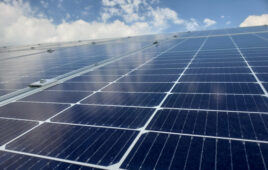As solar technology has improved over the last decade, the prices have dropped exponentially as module efficiency has advanced. In recent years, there’s been a growing concern that we are approaching an efficiency ceiling. People have come to wonder if future solar improvements will be through system solutions, such as coupling solar with storage, rather than through module technology innovation. But, a newer innovation is paving the way to the next generation of module technologies that will revolutionize solar efficiency for many applications.
 Bifacial solar modules have the capability to generate electricity by capturing light from both sides of the module. It does not take a big stretch of the imagination to understand that this type of technology can dramatically shake up the solar market. Bifacial modules produce more energy, and have a lower degradation rate than standard modules. When assessing the financial returns of projects over their life cycle, these modules promise significant LCOE savings.
Bifacial solar modules have the capability to generate electricity by capturing light from both sides of the module. It does not take a big stretch of the imagination to understand that this type of technology can dramatically shake up the solar market. Bifacial modules produce more energy, and have a lower degradation rate than standard modules. When assessing the financial returns of projects over their life cycle, these modules promise significant LCOE savings.
Because bifacial modules can generate power from the front and back of the module, they require less labor costs and balance of system costs to produce the same amount of energy. They can also produce more energy from the same project footprint, with minimal additional installation costs. Bifacial modules offer substantial savings for solar project financers.
Bifacial models are equipped with better cell technology. By using monocrystalline silicon cells, these bifacial modules offer customers much better energy conversion rates than traditional, polycrystalline PV modules. With higher efficiency cells and dual-glass structure, comes a more durable, efficient system that can reduce project costs across the board and significantly increase equipment longevity. Bifacial modules on the market can produce up to 30% more electricity than an equivalent monofacial module in certain environments. And, because of the increased durability, these modules can be offered with an extended warranty of 30 years at just 0.5% annual degradation rate.
Trina Solar recently won its first order for bifacial modules, for a utility-scale project in Golmud, Qinghai, China. The sandy surface on which this project is situated reflects a lot of light, making it ideal for bifacial modules. The project uses a tracker system, maximizing energy capture. This represents the second-largest order of bifacial modules in the world to date.
Bifacial solar modules are a disruptor technology to be excited about. The versatility of these products will allow a diverse portfolio of customers to invest in solar because of the benefits bifacial modules can deliver. These modules work great for utility projects, rooftops and specialty installations, such as floating solar projects. So, the next time someone says there’s not much more room for efficiency improvements in the solar market – let them know a new chapter in solar has just begun.
This article was contributed by Rijal Parjanya, product marketing manager at Trina Solar





We have just started using bifacial modules, the results have been surprising with about a 13% energy gain.
Justo,
Yes, you can use them as a noise barrier, solar panels have been in used in Europe in this manner. A bifacial solar wall. Prism Solar Technologies is a US manufacturer that is excellent (https://www.prismsolar.com/ ). Their backside flash test is 95% of the front side and they warrant their backside production to 90% of the frontside.
The efficiency would of course depend on the azimuth/direction of the wall and Prism would assist you in those calcs. North South would be excellent especially in a state where the utilities have time of use rates.
One of the main advantages for rooftop in addition to the average backside production of 15-21% is that according to Prism’s PLR (IRS) a significant portion of the reroofing cost can be converted to an energy property.
Hi there.
This is Justo Vera, a Miami based Architect and a Solar enthusiast. We are an Architectural Firm.
Questions:
1) For an Urban project our office is proposing: Can we use this kind of panels to install them in vertical position in a Noise Barrier we are including in our proposed site plan to separate the project land from an existing highway ?
2) If yes, and having the panels different efficiency on each face: What percentage of total efficiency could we talk about?
3) Are these panels currently in production maturity, or are them in an experimental stage?
4) What manufacturers can we contact in USA (if existing) or in other Countries, to know about availability, prices, specs, etc. Can you please, provide us with some contact info?
Comments:
Our proposed Sound barrier will run North-South, so, we will have ideal exposure condition facing East and West. Thanks in advance.
We have started installing them in Cape Town South Africa and have noticed a 10% increase in power generation when installing on a white or silver roof.
Hi Raj,
The front side efficiency is about 21.7%, the back side efficiency is 14.3%. The total energy is dependent on the amount of light reflected on to the back of the panel.
The thermal characteristics of the glass is similar to that of a standard backsheet/encapsulant, so the heat dissipation is does not differ much from a standard module.
Parjanya RIjal